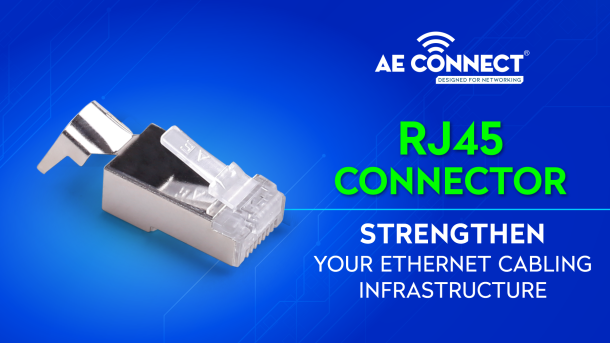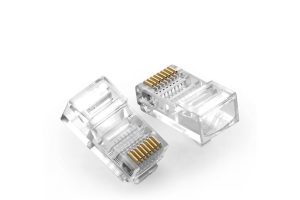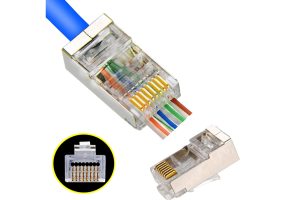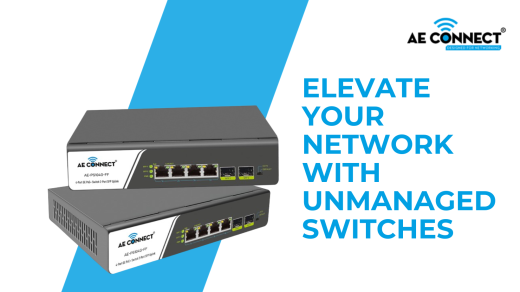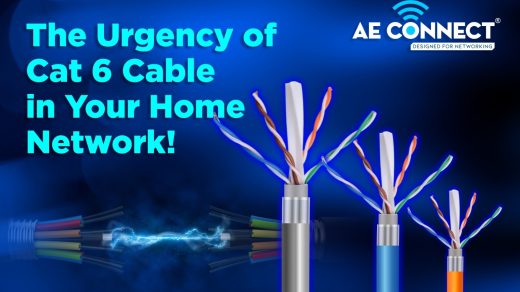As an alternative to wireless or Wi-Fi networks between devices, wired Ethernet connections are always preferred. The main reason behind this is that Ethernet connections provide faster transfer speed when compared to wireless networks and prevent the interception of sensitive data by hackers. In both professional and domestic environments, today Ethernet Networks are commonplace. A Networking System is a combination of several interconnected devices which are capable of sharing data with one another.
Home Networks are usually based around a modem or router sharing data across various devices such as smart TVs, mobile phones, games consoles, PCs, laptops, media servers, printers etc. The Domestic Setup is known as Local Area Network because all linked devices are closed to each other generally within the same building.
If all the devices are interconnected wirelessly then there is no requirement of Ethernet or RJ45 cabling. However, if devices are connected physically then a wired connection for better speed and stability of data transfer is the suitable choice. Wired connections have a small plastic plug fitted at both ends. Corresponding sockets on the respective connected devices allow plugging to slot easily, making a secure network connection. Socket fittings and modular plugs which are used are known as RJ45 Connectors.
The rapid growth of today’s Networking Infrastructure is possible only because of the huge demand for superfast internet connectivity. Technological researchers are working day and night to design and manufacture networking equipment and components that ensure a seamless and high-speed data transmission experience. However, getting the desired level of networking can only be possible with high-performing networking equipment, components and tools.
Various types of Networking equipment and components are part of today’s Networking Infrastructure such as PoE Switches, Industrial PoE+ Switches, LTPoE++ Injectors, Fiber Switch, Fiber Optic Cables, Structure LAN Equipment etc. RJ45 Connectors work as a useful element of all these equipment. Before we dive deeper into the advantages, applications and broader segment of analyzing the existence of RJ45 connectors let’s first read on what are the RJ45 Connectors? Why do these RJ45 Connectors have so much importance in networking infrastructure? What are the different types of RJ45 Connectors available in the market? In order to give a detailed approach to finding your suitable RJ45 Connectors, we’ll also share some benefits of using RJ45 connectors from AE Connect.
What are the RJ45 Connectors?
The term RJ45 is used for Registered Jack 45 which means that it is part of a universally standardised networking interface. To ensure the full compatibility between telephone company hardware and consumer equipment, these registration interfaces were designed in the 1970s. The latest standardised range of plugs and jacks were released as a series of miniature modular connectors – RJ45 is only a type of them.
Specifically, the term Registered Jack used to imply the standardised wiring and female sockets. Toda, RJ45 is widely used as a shorthand reference for both female and male components of the modular RJ45 connector system.
RJ45 Connectors appear similar to the familiar telephone jacks and plugs. RJ45 Connectors are used at either end of a wired internet connection. The term RJ45 is widely used today to describe both female RJ45 Sockets/Jacks and male RJ45 Plugs. The RJ45 Plugs, sometimes called modular connectors, are usually found on the end of LAN cables.
These RJ45 Connectors are the telecoms network interfaces and the job of RJ45 Connectors is to link various types of data and voice equipment either directly to each other or to a central hub. In commercial and modern domestic environments, RJ45 connectors are used for plugging an internet-enabled device directly into hardware such as a server, modem or router. These RJ45 connectors are used to connect one network device to another.
RJ45 Connectors are based on “8 Positions 8 Contacts Configuration (8P8C)”. Most Ethernet Data Transmission Cables consist of four twisted-pair wire strands, eight individual wires in total. Male RJ45 Plugs correctly terminate and separate these eight individual wires. RJ45 Connectors are also defined as a mechanically-keyed variant on a generic 8P8C body. Mechanically keyed essentially means that RJ45 Connectors also include an essential tab that is designed to prevent them from being mated with any other socket standards which are electrically incompatible but visually similar. It also prevents accidental disconnection. The Ethernet cabling wires must be inserted into the correct pinout locations on the male connector, for an RJ45 network connector to function properly. To ensure this, it is necessary to follow T568A or T568B wiring standards which have their own colour-wiring convention, achieving two different forms of connectivity.
Also Read:
- How IoT Is Shaping The Future Of The World? Let’s Discuss
- Dreams, Challenges & Empowering Make in India: The Journey of AE Connect
- Know More About The Power of Next-gen Gigabit PoE Injector
What are the types of RJ45 Connectors?
RJ45 Connectors are available in various types along with their most important distinction between the modular male and female versions. Plugs are known as Male whereas Sockets/Jacks are Female. If we discuss the key role of Plugs then these plugs are capable of terminating the wires of an Ethernet Cable and the role of RJ45 sockets is to transfer the electrical data signal to the device. Both these Connectors are designed to fit together securely to provide a stronger connection – both electrical and physical.
RJ45 Socket (Female RJ45 Connectors):
RJ45 sockets are designed for a male RJ45 plug to be inserted into the socket. These sockets are embedded in the body of the connected devices, on wall and panel installations and can be found on the device’s I/O (In/Out) connectivity panel in the case of most consumer PCs, TVs and tech hardware which is usually located along with various other sockets at the back end of the devices.
RJ45 Plug (Male RJ45 Connectors):
RJ45 Plugs are the most popular plug-in components found at either end of Ethernet cables. RJ45 plugs are manufactured from clear, grey, black and white plastic but they can also be available in various other colours and materials. To minimise the risk of EMI interference, improving the quality and stability of the data signal being transferred, professional-grade, high-quality male RJ45 connectors are sometimes shielded in metal.
Field RJ45 Connectors:
A more rugged version of RJ45 connectors is known as a Field RJ45 Connector. It is mainly used in applications where the wiring system is exposed to harsh environmental conditions such as water, dust, vibrations or mechanical stress. Generally, it depends on the type of hazards the Networking System will face, to decide the suitable RJ45 connector for particular networking infrastructure. Field RJ45 connectors are available as both panel-mounted sockets and as cable-cable interconnects. Field RJ45 Connectors also incorporated some additional features for strength and durability, such as heavy environmental shielding, vibration shielding, mechanical stress relief at both the connector-cable and connector-socket interfaces and screw-terminated shields to transfer loads independently of the electrical connections.
Also Read:
- Understand, How Optical Fiber Cables Are Powering the Internet World?
- Know Why Fiber Patch Cords Are Important?
- High-Speed Cat 6 Cables: Network Cable for Modem, Router & LAN
- Industrial PoE Switches: Ensure Security, Versatility & Scalability
Types of RJ45 Connectors AE Connect Offers
1. AE-CONCAT6-B RJ45 Connector
RJ45 Plug Connectors simplify terminations, easy to set up, highly compatible, and reliable One-piece design reduces errors.
- Model: AE-CONCAT6-B
- Used for Cat6
- 4 Pair, 26AWG
- Available in pack of 100
- For use in telephone & security installations
- For specialized telephone installations & communications equipment
2. AE-C6-SFTP RJ45 Connector
RJ45 Plug Connectors simplify terminations Easy to set up, highly compatible, and reliable One-piece design reduces errors high-quality connectors.
- Model: AE-C6-SFTP
- Used for Cat6 and Cat7
- With boot blisters
- Available in pack of 100
- For use in telephone & security installations
- For specialized telephone installations & communications equipment
3. EZ RJ-45 Connector
RJ45 Plug Connectors simplify terminations, easy to set up, highly compatible, and reliable One-piece design reduces errors.
- Model: AE-C6CON-SFTP
- Used for Cat6
- Available in pack of 100
- For use in telephone & security installations
- For specialized telephone installations & communications equipment
The Process of Wiring the RJ45 Connectors:
Knowing about the what is, types, applications and advantages of RJ45 connectors was a way to be more familiar with these connectors. Now it’s time to do some physical activity and let’s start it by performing the task of wiring RJ45 Connectors. By using just a few simple tools anyone can perform the wiring of the RJ45 Connector task, fixing a new connector is usually cheaper than replacing an entire Ethernet cable. Some other reasons to learn the wiring process of RJ45 Connectors include:
- Customizable Length
- Reconnection of wires
- Avoid incorrect connections
- Cast-saving measure
Step-by-Step Guide for Ethernet Cable RJ45 Wiring:
Components and tools that are necessary:
- Ethernet Communication Cable
- For the category of cable used, RJ45 Crimpable Connectors
- RJ45 Crimping Tool
After establishing wiring conventions, complete the wiring process by following these basic steps:
Step 1: By using the cable clutter, if necessary cut your cable to the required length.
Step 2: Trim and tidy the cut ends of the cable by using a crimping tool.
Step 3: In a pair of wire strippers, remove an inch of the cable jacket from the end without damaging any of the internal wirings in the process.
Step 4: Separate and untwist the individual wire strands, flatten and straighten them out as much as possible.
Step 5: Arrange them side-by-side in a line in the correct order by colour.
Step 6: Around half an inch from the cable sleeve, cut the wires straight across at the ends.
Step 7: Hold RJ45 Plug with its contact pins pointing away from you and away from the cable wires and its plug clip facing downwards.
Step 8: Until the arranged wires reach and touch the end of the connector where the pins are, gently push them through the body of the RJ45 plug. Feeding in a half centimetre provides a stronger and better-insulated connection.
Step 9: Once the connector is attached by using the crimping tool, press down tightly on the connector around the cable. Tabs inside the connector will flatten and pierce the individual wires, forcing them into proper contact. Once the wire around the connector is crimped, that end of the cable is ready to be tested for use.
What is a Crimping Tool used in the wiring of RJ45 Connectors?
In the process of joining and connecting two components or pieces of material through compression forces, Crimping Tools are used. To form a fairly permanent bond or seal, the Crimping tool squeezes the two parts tightly. There are a few additional functions of Crimping tools along with the ability to compress and seal materials such as stripping, bending and cutting.
While attaching the Male Plug Connectors to the ends of a suitable cable, RJ45 Crimper is used and it is also known as the RJ45 Connector tool. For quicker, simpler and cost-effective fix or custom cable build, RJ45 Crimp Tools are an ideal choice.
In the Networking Market, numerous options of Crimping Tools are available, some of them are hand-operated crimping tools, hydraulic crimping tools, electric crimping tools, pliers and ratchets. However manual crimping tools or hand-held crimping tools for RJ45 are the simplest and most economical options to use.
What are RJ45 Cables?
Today, a variety of grades referred to as categories of RJ45 cable are sold online and collectively known as networking communication or Ethernet cables, used to achieve super-fast data transmission. Using a set of four twisted pair wires (total eight wires), Ethernet Cables are constructed and some of them are shielded but many of them as Cat5 and Cat6 are unshielded. The higher the category number will be the greater will be the potential speed and data transfer capacity of the cable between directly-linked servers, switches and network devices.
Cable Grades such as Ethernet Cat5e, Cat6 and Cat6a are the most widely used in the majority of standard office and domestic networks. Higher categories such as Cat7 cable are preferred for more demanding situations like wired Gigabit Ethernet. It is an added advantage that cables are backwards compatible.
When deciding the suitable Ethernet Cable, the important distinction is between patch or straight-through cable and crossover cable. Patch or straight-through cable has the same type of wiring at both ends. This is the standard version used in most domestic environments for example connecting devices and PCs to a network hub or router. A Crossover Cable has T568A wiring at one end and a T568B connection at another end. Without passing through an intermediate device or hub such as a router or network switch, it is generally used to link two computers together directly. However, this method is rarely used today.
AE Connect is one of India’s leading manufacturers of high-quality Connectivity and Networking Products. We have been able to build our credibility over the last 15 years with our best-in-class high performing products. Our infrastructure is equipped with advanced machines and appliances to deliver the networking products of the customer’s choice.
We work as a Digital Transformation Partner for all our clients. Along with our smart networking and connectivity products, there are a few other benefits of partnering with AE Connect such as all our products are customized to work in Indian conditions, massive power budget & superior performance of products, and 3 years warranty & extended warranty support.
Our Networking Solutions Include:
– PoE+ Solutions
– Fiber Solutions
– Structure LAN Solutions
– Networking Rack Cabinets
– Networking Tools
For further details related to AE Connect Product Range, click here to contact us.
Also Read:

